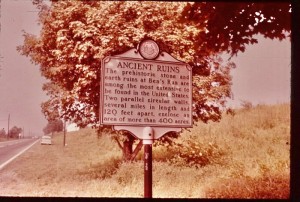
Bens Run in Ohio River valley between Sistersville and St. Marys is in Tyler County very near Pleasants County
From an Article by Cristy, Only In Your State ~ West Virginia, July 7, 2022
West Virginia is known for its large number of ancient burial mounds. These mounds, thought to be thousands of years old, were erected by a native race long predating the American Indians living here when the first white settlers arrived. The largest of these burial mounds measures over 200 feet in diameter and over 60 feet high.
But the secrets within the mounds are even more remarkable. The remains found as these mounds were excavated over the years reveal humans – possibly chiefs or shamans of great honor – buried in complex and unique methods and arrangements. When Grave Creek Mound, the world’s largest conical mound, was excavated in the early 1800s, it was reported that skeletons up to 8 feet tall were discovered inside.
Years later, the Smithsonian Institution performed the excavation of the Criel Mound in South Charleston, another massive mound judged to date to the same time period as Grave Creek Mound. Of the 13 skeletons unearthed, 10 were arranged in a spoke-like pattern around one central skeleton that was 6 feet 8 inches tall.
And in the 1950s, Cresap Mound in Marshall County was excavated by Don Dragoo of the Smithsonian. Among the 54 human skeletons discovered inside, one was found to be over 7 feet in length.
Over the years, many other human skeletons or individual bones unearthed across the state (and in neighboring states) were reported to be abnormally large, although none of these have been preserved until today. There is, however, no shortage of controversy surrounding some of these claims.
Some modern scholars allege that many of the early discoveries were not measured correctly or that they were misidentified due to the researchers’ lack of scientific training. Others, in turn, have theorized that the Smithsonian orchestrated a coverup of evidence of giant skeletons for unknown reasons. This stems from two burial mounds in Doddridge County that were excavated in 1930 by professor Ernest Sutton of Salem University. He allegedly found human skeletons from seven to nine feet tall, and the artifacts reported to have been turned over to the Smithsonian. However, the skeletons were apparently stolen and have disappeared, which (together with later revision of measurements) has spawned the coverup theory.
#######+++++++#######++++++++########
What Happened to the Fort Ancient People? | Darla Spencer, 2016
New book examines myths and misconceptions of elusive Native Americans. See also Wikipedia for the status of understanding of the Fort Ancient culture.
A Native American community known as the Fort Ancient once existed in what is now West Virginia. The Fort Ancient people lived along major rivers between roughly A.D. 1000 and 1700, but by the time the first Europeans settled in the Ohio Valley and Kanawha Valley, they were gone.
“Early Native Peoples in West Virginia: The Fort Ancient Culture” by West Virginia University Native American Studies Lecturer Darla Spencer, examines what archaeologists know about the Fort Ancient culture.
